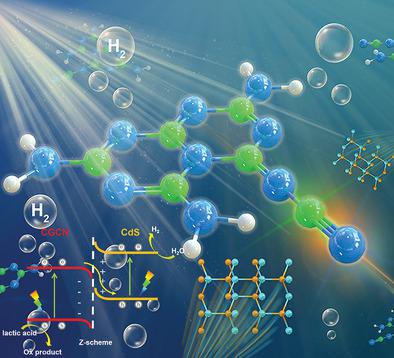Our official English website, www.x-mol.net, welcomes your
feedback! (Note: you will need to create a separate account there.)
Photodepositing CdS on the Active Cyano Groups Decorated g-C3N4 in Z-Scheme Manner Promotes Visible-Light-Driven Hydrogen Evolution
Small ( IF 13.0 ) Pub Date : 2021-08-16 , DOI: 10.1002/smll.202102699
Zhipeng Wang 1 , Zilin Wang 1 , Xiaodi Zhu 2 , Changzhi Ai 1 , Yamei Zeng 1 , Wenyan Shi 3 , Xidong Zhang 1 , Haoran Zhang 1 , Hewei Si 1 , Jin Li 4 , Cai-Zhuang Wang 5 , Shiwei Lin 1
Small ( IF 13.0 ) Pub Date : 2021-08-16 , DOI: 10.1002/smll.202102699
Zhipeng Wang 1 , Zilin Wang 1 , Xiaodi Zhu 2 , Changzhi Ai 1 , Yamei Zeng 1 , Wenyan Shi 3 , Xidong Zhang 1 , Haoran Zhang 1 , Hewei Si 1 , Jin Li 4 , Cai-Zhuang Wang 5 , Shiwei Lin 1
Affiliation

|
g-C3N4/CdS heterojunctions are potential photocatalysts for hydrogen production but their traditional type-II configuration generally leads to weak oxidative and reductive activity. How to construct the novel Z-scheme g-C3N4/CdS counterparts to address this issue remains a great challenge in this field. In this work, a new direct Z-scheme heterojunction of defective g-C3N4/CdS is designed by introducing cyano groups (NC-) as the active bridge sites. Experimental observations in combination with density functional theory (DFT) calculations reveal that the unique electron-withdrawing feature of cyano groups in the defective g-C3N4/CdS heterostructure can endow this photocatalyst with numerous advantageous properties including high light absorption ability, strong redox performance, satisfactory charge separation efficiency, and long lifetime of charge carriers. Consequently, the resultant photocatalytic system exhibits more active performance than CdS and g-C3N4 under visible light and reaches an excellent hydrogen evolution rate of 1809.07 µmol h−1 g−1, which is 6.09 times higher than pristine g-C3N4. Moreover, the defective g-C3N4/CdS photocatalyst maintains good stability after 40 h continuous test. This work provides new insights into design and construction of Z-scheme heterojunctions for regulating the visible-light-induced photocatalytic activity for H2 evolution.
中文翻译:

以 Z 型方式在 g-C3N4 装饰的活性氰基上光沉积 CdS 促进可见光驱动的氢演化
gC 3 N 4 /CdS异质结是潜在的制氢光催化剂,但其传统的II型构型通常导致氧化和还原活性较弱。如何构建新的Z-scheme gC 3 N 4 /CdS 对应物来解决这个问题仍然是该领域的一个巨大挑战。在这项工作中,通过引入氰基(NC-)作为活性桥位,设计了一种新的有缺陷的gC 3 N 4 /CdS 的直接Z 型异质结。结合密度泛函理论 (DFT) 计算的实验观察表明,缺陷 gC 3 N 4中氰基的独特吸电子特征/CdS异质结构可以赋予这种光催化剂许多有利的特性,包括高吸光能力、强氧化还原性能、令人满意的电荷分离效率和电荷载流子的长寿命。因此,所得光催化体系在可见光下表现出比CdS和gC 3 N 4更高的活性,并达到1809.07 µmol h -1 g -1的优异析氢速率,是原始gC 3 N 4 的6.09倍。此外,有缺陷的 gC 3 N 4/CdS 光催化剂在连续测试 40 h 后仍保持良好的稳定性。这项工作为设计和构建 Z 型异质结以调节可见光诱导的 H 2析出光催化活性提供了新的见解。
更新日期:2021-10-01
中文翻译:

以 Z 型方式在 g-C3N4 装饰的活性氰基上光沉积 CdS 促进可见光驱动的氢演化
gC 3 N 4 /CdS异质结是潜在的制氢光催化剂,但其传统的II型构型通常导致氧化和还原活性较弱。如何构建新的Z-scheme gC 3 N 4 /CdS 对应物来解决这个问题仍然是该领域的一个巨大挑战。在这项工作中,通过引入氰基(NC-)作为活性桥位,设计了一种新的有缺陷的gC 3 N 4 /CdS 的直接Z 型异质结。结合密度泛函理论 (DFT) 计算的实验观察表明,缺陷 gC 3 N 4中氰基的独特吸电子特征/CdS异质结构可以赋予这种光催化剂许多有利的特性,包括高吸光能力、强氧化还原性能、令人满意的电荷分离效率和电荷载流子的长寿命。因此,所得光催化体系在可见光下表现出比CdS和gC 3 N 4更高的活性,并达到1809.07 µmol h -1 g -1的优异析氢速率,是原始gC 3 N 4 的6.09倍。此外,有缺陷的 gC 3 N 4/CdS 光催化剂在连续测试 40 h 后仍保持良好的稳定性。这项工作为设计和构建 Z 型异质结以调节可见光诱导的 H 2析出光催化活性提供了新的见解。







































 京公网安备 11010802027423号
京公网安备 11010802027423号